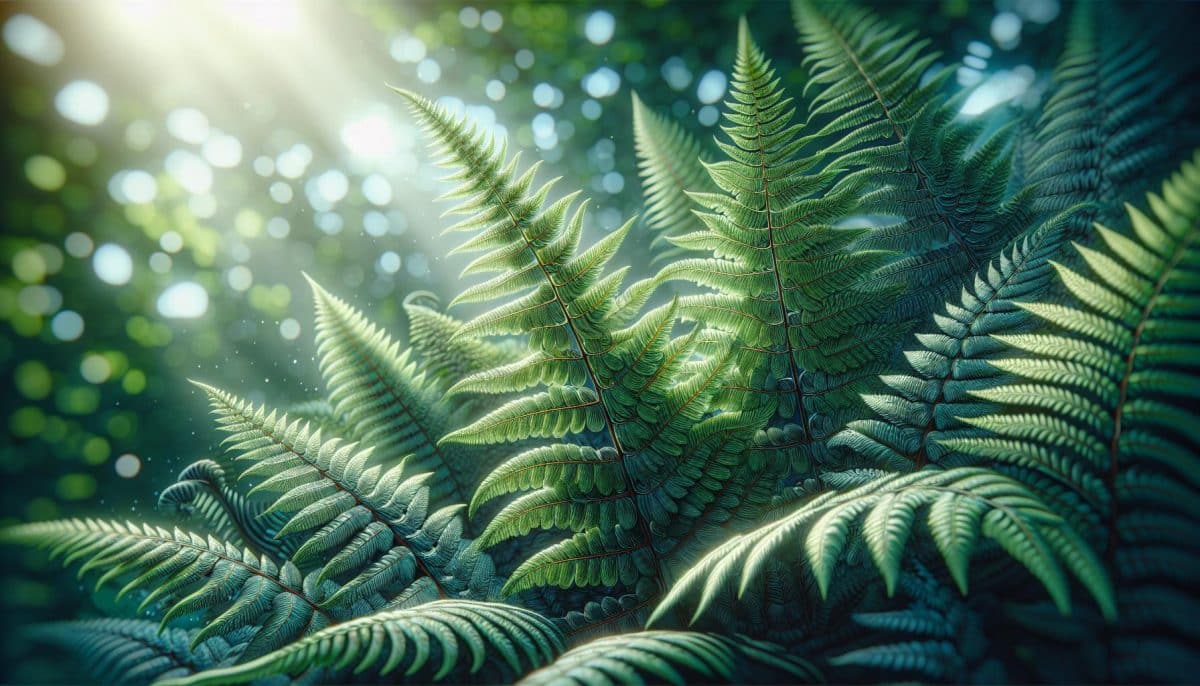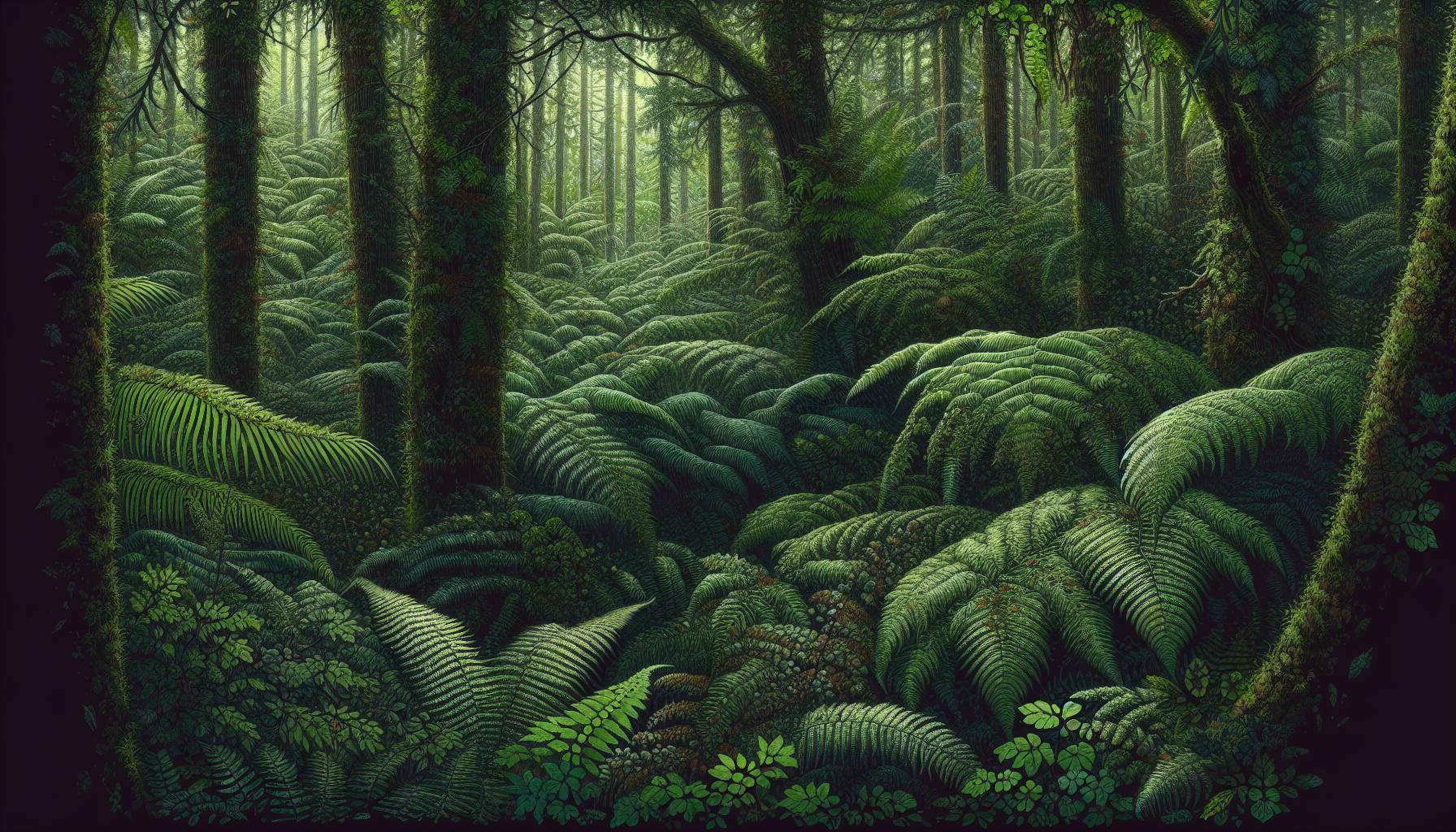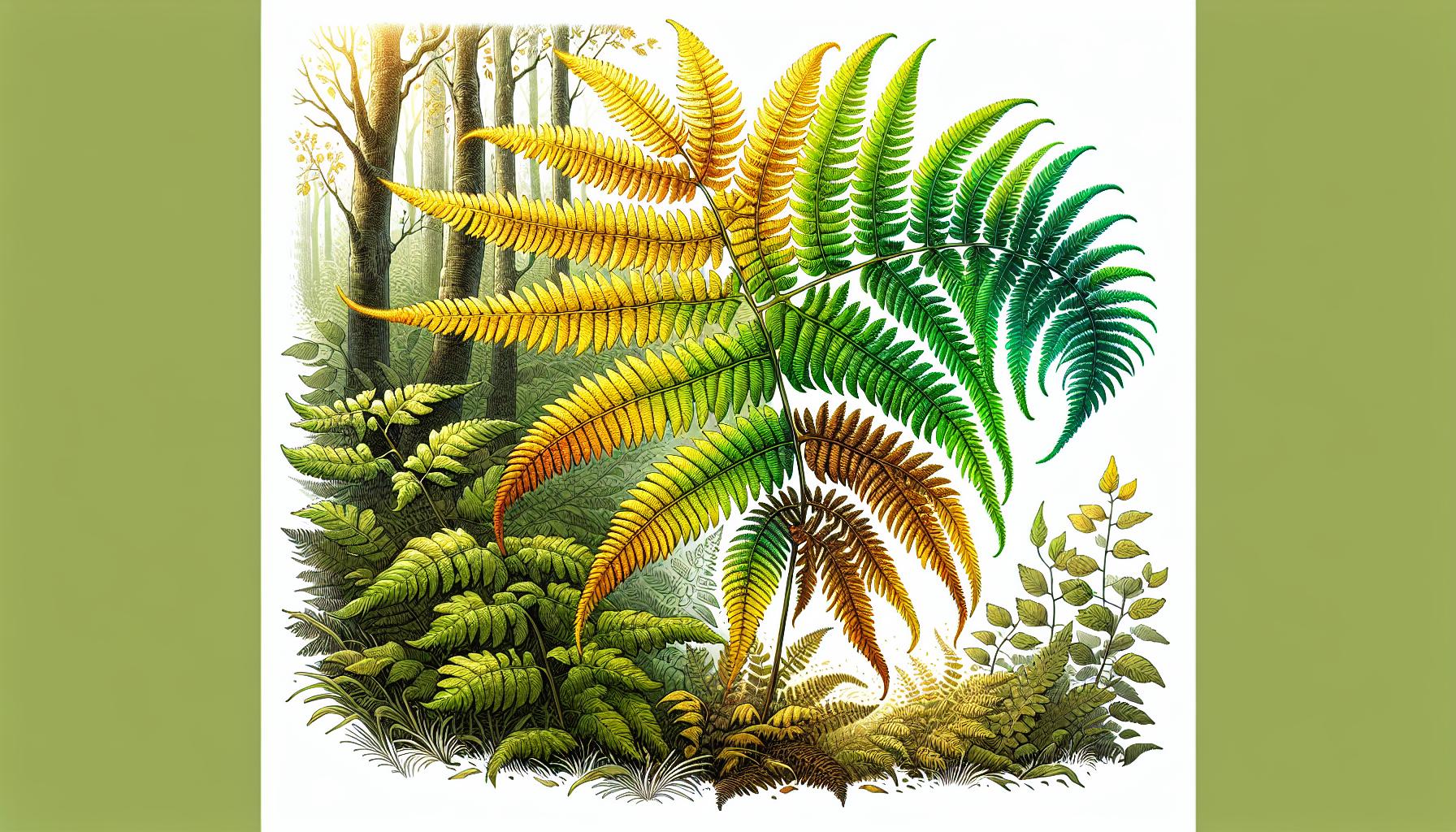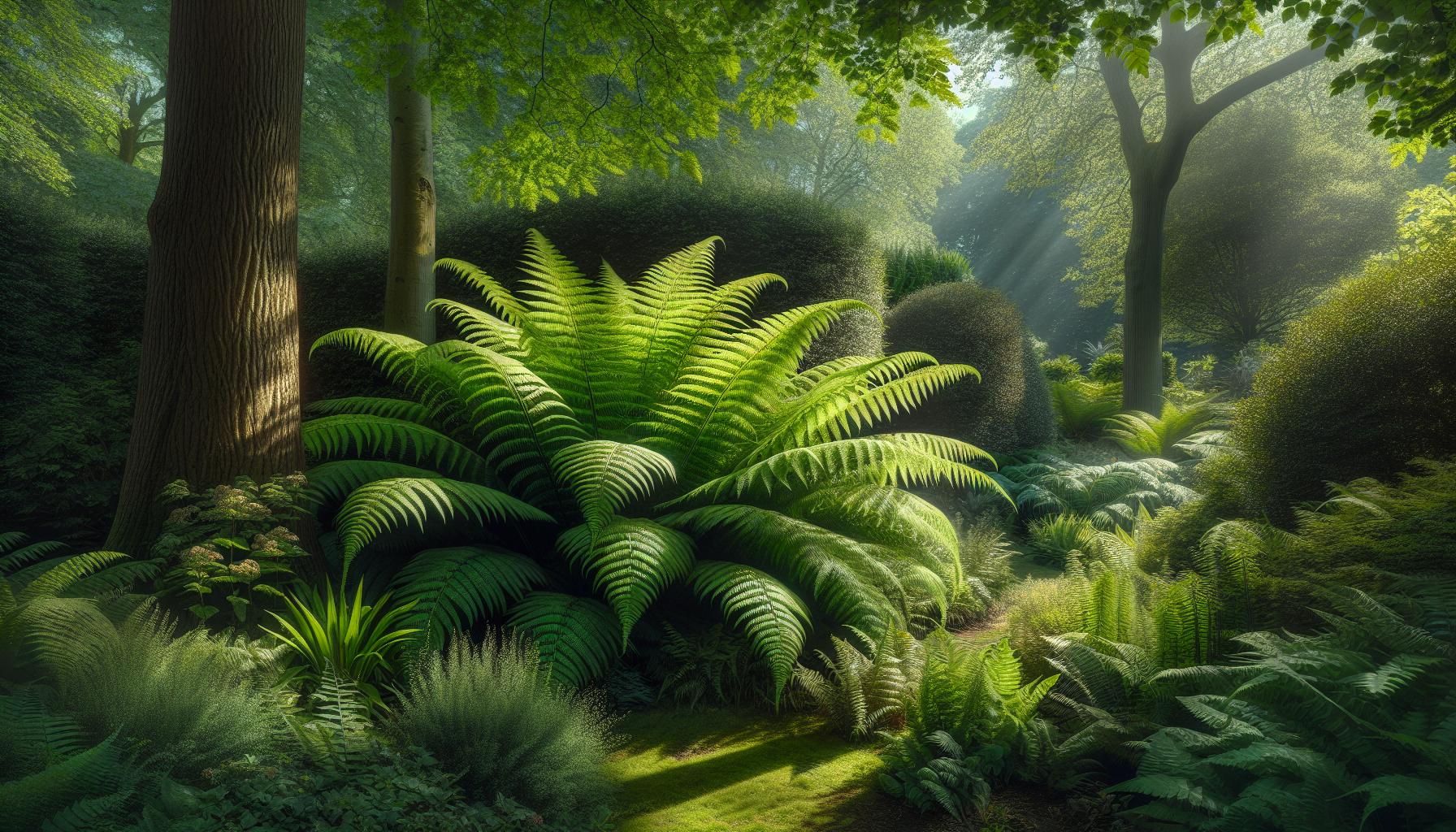
Ever wondered if those lush ferns you’ve admired in gardens and woodlands keep their verdant charm all year round? Well, you’re not alone. Ferns, with their feathery fronds and ancient lineage, often spark curiosity about their evergreen nature.
In the plant world, ‘evergreen’ refers to plants that maintain their leaves throughout the seasons. While many ferns fit this bill, boasting green fronds even in the chill of winter, it’s not a one-size-fits-all answer. Let’s delve into the fascinating world of ferns to uncover their secrets.
What Are Ferns?
When you delve deeper into the green world around you, you’ll find that ferns are an ancient group of plants. These non-flowering plants belong to the Pteridophyta division, known for their unique reproductive cycles. Unlike flowering plants that produce seeds, ferns reproduce via spores. The lifecycle of a fern is a two-phase journey involving both asexual and sexual stages, which ensures their survival across various conditions.
Ferns have a vascular system, which sets them apart from other spore-producing plants like mosses. This system allows them to grow larger, as it transports water and nutrients effectively throughout the plant. You’ll often find ferns in moist, shaded environments worldwide, from tropical rainforests to temperate woodlands.
The structural beauty of ferns lies in their fronds, which are the leaves of the plant. These fronds grow from a rhizome, a stem that is usually found underground. The new fronds unroll in a graceful process known as circinate vernation, spiralling outwards in a pattern that has fascinated botanists for centuries.
Most ferns are perennial, with many species being evergreen. However, even within the realm of evergreens, the lifespan of the fronds can vary. Some remain green all year, in every season, while others may shed their fronds when the environment demands, only to regrow them when conditions improve.
Understanding the biology of ferns allows you to appreciate their resilience and the role they play in ecosystems. Their lush green fronds contribute to the understory of forests, providing habitats for various wildlife while also playing a crucial part in preventing soil erosion.
In your exploration of these plants, you’ll discover that the world of ferns is incredibly diverse. With roughly 10,000 known species worldwide, they offer a plethora of shapes, sizes, and adaptations. Fern enthusiasts find joy in the fact that there is always more to learn and more varieties to encounter.
Understanding Evergreen Plants

When you delve into the realm of evergreen plants, you’ll find that their defining trait is the ability to maintain leaves throughout the year. Unlike deciduous plants that shed their foliage seasonally, evergreens such as pine trees, hollies, and certain species of ferns keep their greenery regardless of the season. This characteristic isn’t just for show; it serves critical ecological functions.
Evergreen plants offer several benefits:
- Year-Round Photosynthesis: Evergreen plants continue to photosynthesize throughout the year, providing oxygen and using up carbon dioxide even in colder months when deciduous plants are dormant.
- Shelter for Wildlife: Birds and small mammals often rely on the consistent coverage evergreens provide to protect them from predators and harsh weather conditions.
- Soil Stability: The persistent foliage and root systems of evergreen plants help prevent soil erosion, especially in areas where sudden bareness in winter could leave soil vulnerable.
A notable example of an evergreen’s impact comes from the Scottish highlands, where Scots pine trees create a year-round habitat for capercaillies, a bird species that depends on the continuous cover for survival.
Evergreen ferns like the Christmas fern and the Wood fern also demonstrate these benefits. Their evergreen nature ensures that the forest floor stays lush, offering a permanent microhabitat for insects and understory species. Thus, the evergreen characteristic of ferns enriches the biodiversity of their environments and contributes to the stability of their ecosystems.
Ferns and Photosynthesis
Diving deeper into the photosynthetic benefits, evergreen ferns are powerhouses in low-light conditions found in dense forests. They’ve adapted to efficiently capture the filtered sunlight and maintain a steadier rate of photosynthesis all year. This adaptation is crucial not only for their survival but also for supporting the woodland creatures that depend on them for food and shelter.
Habitat Provision
The consistency of evergreen ferns creates a reliable sanctuary for numerous species. The intricate layers of fern fronds offer a shield against snow and provide a microclimate that supports various stages of life cycles, from amphibians to insects.
Through these attributes, evergreen plants, including certain fern species, exemplify resilience and sustenance within their communities. As you walk through an evergreen forest, you’re not just witnessing plants that don’t shed their leaves; you’re in the midst of an intricate, life-supporting system that operates year-round.
The Evergreen Myth: Do All Ferns Stay Green Throughout the Year?

Exploring the colorful world of ferns, you may come across the common belief that all fern species maintain their verdant hue year-round. However, this isn’t strictly true. Ferns, just like any other plant group, exhibit a range of behaviors when it comes to retaining their color.
While many ferns are indeed evergreen, keeping their leaves through the winter, a surprising number are deciduous. Deciduous ferns, such as the Ostrich Fern and the Bracken, shed their fronds when temperatures drop and resources become scarce. This allows them to conserve energy and avoid damage from harsh weather conditions.
In contrast, evergreen fern species like the Christmas Fern and the Holly Fern have adapted to hold onto their foliage. They do this by developing thicker, tougher leaves that withstand cold and dehydration better than their deciduous counterparts. This trait provides critical year-round habitat for wildlife, as well as ongoing erosion control and soil stabilization.
Bear in mind, that even among evergreens, the shade of green may vary and tend to darken or dull as the seasons change. But don’t be fooled by a fern’s wintertime color; it’s all part of their unique adaptation mechanisms to survive until spring rejuvenates their vibrant hues.
Nevertheless, whether evergreen or deciduous, ferns have a profound effect on their environments. Their presence bolsters the ecosystem’s health and complexity, offering benefits that extend far beyond their visual appeal. Ferns exemplify the diversity in adaptation and survival strategies in the plant kingdom, confirming that they’re not bound by a single ‘evergreen’ label.
Deciduous Ferns: Shedding Light on the Seasonal Changes

When you explore the world of ferns, you’ll notice that not all ferns are designed to be evergreen. Deciduous ferns shed their fronds annually, often in response to cooler temperatures and reduced daylight. Unlike their evergreen relatives, these ferns withdraw nutrients from their fronds and store them in their roots before the leaves wither and fall. This seasonal shift is not only a fascinating adaptation but also serves key ecological functions.
Deciduous ferns are environmentally tuned, with many displaying spectacular autumnal colours before their leaves drop. This process often reveals a surprising variety of hues, from golden yellow to rustic browns. Importantly, the fallen fronds contribute to the forest floor’s nutrient cycle, creating a natural mulch that enriches the soil and supports a plethora of microorganisms vital for ecosystem health.
One striking example of a deciduous fern is the Ostrich Fern (Matteuccia struthiopteris), renowned for its dramatic, shuttlecock-like frond display which gracefully arches over before dying back in winter. This dieback allows for other species to flourish in the area, showcasing the ferns’ role in providing opportunities for biodiversity.
The energy conservation strategy of deciduous ferns is equally impressive. By shedding their fronds, these ferns reduce the energy needed to maintain leaves during periods of stress, such as cold or drought. This ensures their survival through tough conditions and positions them to quickly regrow when the season turns favourable.
Ultimately, the seasonal dynamics of deciduous ferns are a testament to nature’s ingenuity, allowing these plants not only to survive but to thrive within their respective habitats. The recurring life cycle of these ferns provides an extraordinary spectacle that also enriches the ecosystems in which they dwell.
Evergreen Ferns: Unveiling the Year-round Beauty

While deciduous ferns retreat in winter, evergreen ferns retain their lush appearance throughout the seasons. If you have a shaded garden or a desire for green during the chillier months, these ferns are ideal. Unlike their deciduous cousins, evergreen ferns hold onto their fronds all year, effectively providing a constant display of verdure and a habitat for wildlife even when other plants have succumbed to the cold.
Among the most robust evergreen species is the Christmas Fern, named for its verdant fronds during the holiday season. It’s not just festive by name; this fern epitomises resilience, thriving in the harshest conditions when others fade. Another noteworthy example is the Hart’s Tongue Fern, with its unique strap-shaped leaves that stand out in any woodland garden setting.
Cultivating evergreen ferns comes with multiple benefits:
- They offer year-round ground cover, reducing soil erosion and suppressing weeds.
- Their persistent greenery provides a haven for wildlife during sparse winter months.
- Evergreen ferns act as natural air purifiers, contributing to a cleaner environment.
It’s fascinating to consider that within the same family, ferns exhibit such diverse survival strategies. Whether they’re deciduous or evergreen, these ancient plants have persisted through millennia. Their secret? Perhaps it lies in their adaptability and the subtle balance they maintain with their surroundings. Evergreen ferns, in particular, seem to have mastered the art of year-round survival without the need to retreat but rather stand as unwavering tokens of green resilience.
Conclusion
You’ve seen how evergreen ferns stand out with their perpetual verdure, offering more than just aesthetics. They’re a steadfast source of cover and life, even when the rest of the landscape succumbs to the chill of winter. With choices like the Christmas Fern and Hart’s Tongue Fern, you’re equipped to create a garden that thrives throughout the year. Embrace the hardiness and environmental benefits of these ancient plants and enjoy the lush, green sanctuary they provide, whatever the season may be.
Colin Macmillan is a seasoned entrepreneur and the CEO of Riverwood Landscape, a leading landscaping company based in Canada. He has been at the helm of the company since leaving high school, demonstrating his strong leadership skills and business acumen.
Colin’s expertise lies in various aspects of landscaping, including lawn care, interlocking, sod installation, and commercial maintenance. His hands-on approach and dedication to the craft have been instrumental in building Riverwood Landscape into a reputable brand.
One of his most notable achievements is the creation of a successful landscape franchise that services multiple locations. This accomplishment underscores his strategic thinking and ability to scale operations effectively.
Colin has also had the privilege of working with Guelph Hospital for landscaping and maintenance, a testament to the trust and reliability that his company has earned over the years.
His professional mission is to offer the best services and experiences for customers, a goal that he tirelessly pursues. Colin’s commitment to excellence and customer satisfaction continues to drive the growth and success of Riverwood Landscape.








